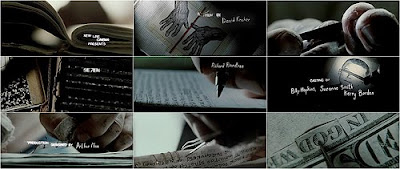
This is the opening sequence of the movie 'Momento', directed by Christopher Nolan; created in 2002.
The title of the film:
The title of the film is shown to us near the beginning of the film opening, as the title ‘Memento’ appears in blue letters; allowing an easy viewing due to the black background. The titles fade in and out, creating an eerie and creepy atmosphere, which is what you feel for the whole duration of the movie. The actors, and various members that were included in the film are shown in the opening sequence, and this happens quite slowly. A title sequence is traditionally slow paced, which is what this opening sequence is; again an eerie atmosphere has been created due to this decision made.
Setting/Location:
The viewer is able to see the location at which this movie is set shortly after we see the ‘Memento’ title fade out, and we are shown a close up shot of a hand holding a Polaroid picture. Initially, we want to know more, why is he holding this picture and what significance is this to the movie. Also, we want to know why this image is fading, and why it appears that this clip is ‘reversed’. Traditionally, an opening sequence needs to set the scene and make the viewer want to know more, and this is exactly what ‘Memento’s’ opening sequence does. We have so many questions that we want answered, we want to know why this image is fading, and we want to know why he is situated in this place; finally we want to know why this clip has been reversed, and what significance this has.
Key props:
The opening sequence of ‘Memento’ has merely one key prop, and that is the Polaroid picture. This is due to the fact that a close up is used to show this image, merely connoting a lot of importance within the film. This image and the actual title of the film connect very cleverly, as a picture can be seen as a memento; but also the main character uses pictures to remember things as he has lost his short term memory due to an incident, therefore the Polaroid picture has great significance.
Title font, placement and style:
The opening sequence is just a black screen, but then names of significant members of the movie fade in and out, along with the title ‘Memento’. Possibly having simplistic fonts makes the viewer think that this film is going to be simplistic, yet I know that this movie isn’t, it is actually a complicated yet effective film. These titles are placed in the middle of the screen, and these titles are all a light blue colour. The colour blue is very calming, yet this film is not a calm film and again this is opposite as to what the film actually is.
Camerawork of the opening sequence:
The opening sequence doesn’t contain many camera angles used, it is only a close up of the Polaroid picture. Maybe, Christopher Nolan wanted to ‘draw the audience in’ before anything spectacular is revealed; he may have wanted to calm the audience down, and he would want the audience even more engaged. The use of just this one shot type is very effective, as the audience will want to know who is holding that image, and why they are holding it. Moreover, what significance this has to the rest of the film. They will also want to know who the person is in the picture, and by having a close up of this picture a clear implication is shown with the use of the shot.
The opening sequence in relation to rest of the film:
Ultimately, the beginning of the movie is the ending of the movie; therefore the ending is shown at the beginning. This will then make the viewer want to know more, and know why these activities have occurred. Also, the opening sequence contains the Polaroid picture, which in relation to the movie is closely linked. Throughout the movie, the main character uses Polaroid pictures to keep as‘documentation’ for what has recently happened in his life, because he has lost his short term memory.
In addition to this, the music in the opening sequence starts off slowed paced, just as an opening sequence should be. I believe this will ‘draw the view in’, and make them want to watch on. Also, the music creates this creepy atmosphere that is needed within a 'Thriller' and this makes the viewer a little on edge as they are unsure of what to expect from the movie. They know something sinister is going to occur, but they just don’t know when this will happen.

